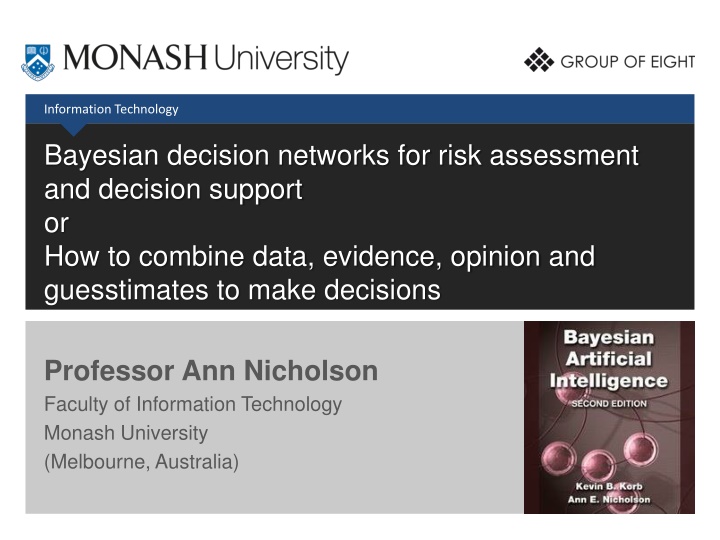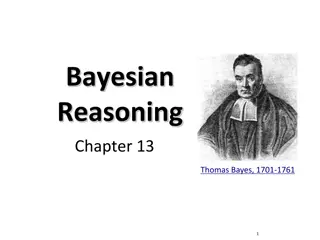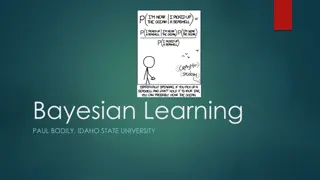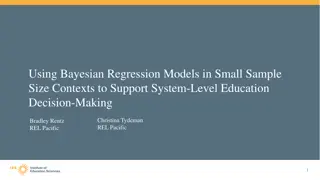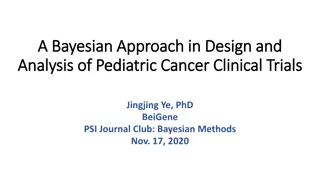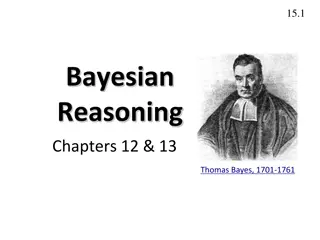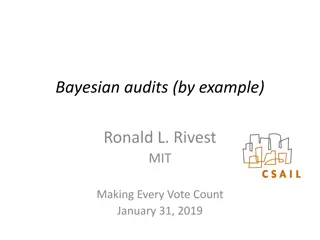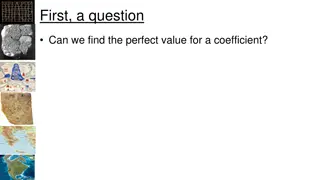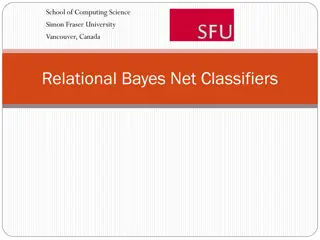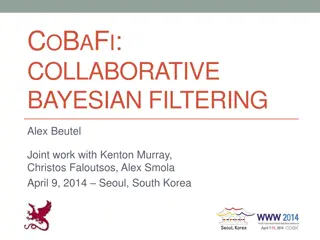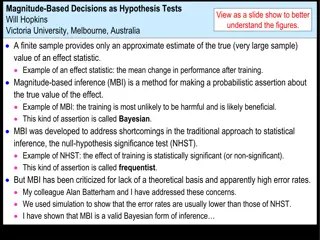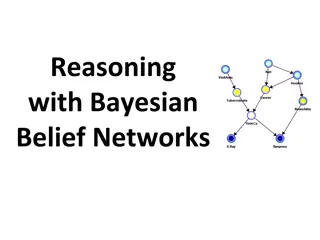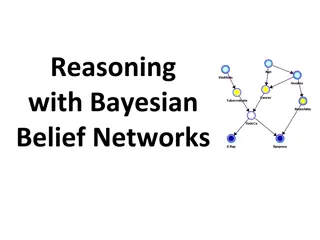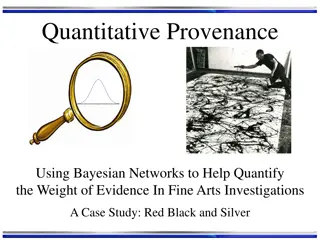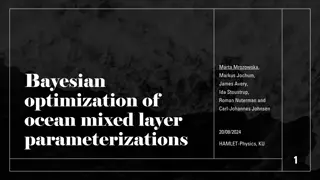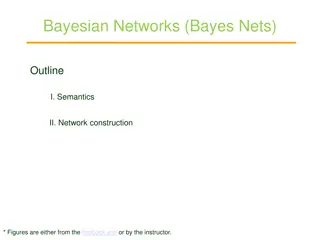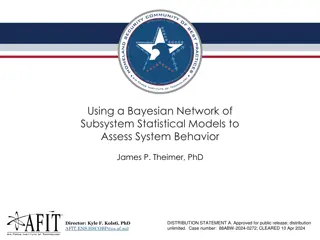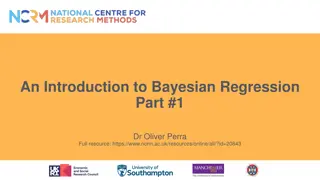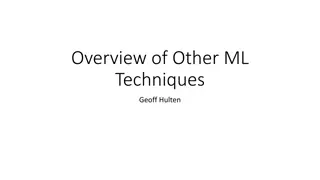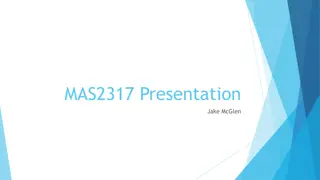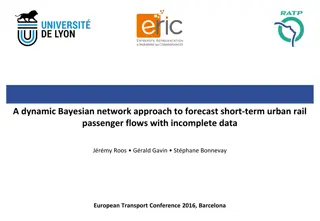Bayesian Decision Networks in Information Technology for Decision Support
Explore the application of Bayesian decision networks in Information Technology, emphasizing risk assessment and decision support. Understand how to amalgamate data, evidence, opinion, and guesstimates to make informed decisions. Delve into probabilistic graphical models capturing process structures and quantifying uncertainties. Follow the reasoning process of updating beliefs with new information and utilizing the Bayesian approach to represent uncertainties with probabilities. Learn about Bayes' Theorem for estimating risks and Bayesian networks for probabilistic reasoning under uncertainty.
Uploaded on Nov 13, 2024 | 2 Views
Download Presentation

Please find below an Image/Link to download the presentation.
The content on the website is provided AS IS for your information and personal use only. It may not be sold, licensed, or shared on other websites without obtaining consent from the author.If you encounter any issues during the download, it is possible that the publisher has removed the file from their server.
You are allowed to download the files provided on this website for personal or commercial use, subject to the condition that they are used lawfully. All files are the property of their respective owners.
The content on the website is provided AS IS for your information and personal use only. It may not be sold, licensed, or shared on other websites without obtaining consent from the author.
E N D
Presentation Transcript
Information Technology Bayesian decision networks for risk assessment and decision support or How to combine data, evidence, opinion and guesstimates to make decisions Professor Ann Nicholson Faculty of Information Technology Monash University (Melbourne, Australia)
Probabilistic Graphical Models For a capture the process structure (not black box) and quantify the uncertainty target system Why use models? Increases understanding Supports decision making Use new data and evaluation to improve over time
The reasoning process 1. Start with a belief in a proposition Beliefs Very unlikely 1% chance Odds of 100 to 1 0.01 probability From Gut feeling Expert opinion Data The proportion of people with insufficient calorie intake is 10-20% There will be a locust plague this summer Wheat prices will fall next year Unemployment is high
The reasoning process 2. New information becomes available 1. Start with a belief in a proposition The proportion of people with vitamin deficiencies is 10-20% There will be a locust plague this summer Wheat prices will fall next year Unemployment is high Child mortality rates in region X are double region average Large egg nests observed Country X is expecting record harvests Food bank numbers are twice average But how? 3. Update your beliefs
The Bayesian approach Represent uncertainty by probabilities Use Bayes theorem: h = hypothesis e = evidence Starting belief= prior P(h|e) = P(e|h) P(h) P(e) New belief The Rev. Thomas Bayes 1702?-1761
Bayes Theorem for Estimating Risk Suppose: h= the athlete is taking steroids e= test result is positive And: P(h) = 0.01 (one in 100 people) P(e|h) = 0.8 (true positive rate) P(e|not h) = 0.1 (false positive rate) 0.075 (7.5%) What is P(h|e)? In general, people can t do Bayes Theorem (well) off hand! And how do we scale up to X1, X2, .. X100, . X1000 ??
Bayesian Networks Developed by graphical modeling & AI communities in 1980s for probabilistic reasoning under uncertainty Many synonyms Bayes nets, Bayesian belief networks, directed acyclic graphs, probabilistic networks Judea Pearl 2012 Turing Award
Native Fish Example A local river with tree-lined banks is known to contain native fish populations, which need to be conserved. Parts of the river pass through croplands, and parts are susceptible to droughtconditions. Pesticides are known to be used on the crops. Rainfall helps native fish populations by maintaining water flow, which increases habitat suitability as well as connectivity between different habitat areas. However rain can also wash pesticides that are dangerous to fish from the croplands into the river. There is concern that the trees and native fish will be affected by drought conditions and crop pesticides. See http://bayesianintelligence.com/publications/TR2010_3_NativeFish.pdf
What are Bayesian networks? A graph in which the following holds: 1. A set of random variables = nodes in network 2. A set of directed arcs connects pairs of nodes 3. It is a directed acyclic graph (DAG), i.e. no directed cycles 4. Each node has a conditional probability table or distribution (CPT or CPD) that quantifies the effects the parent nodes have on the child node Node = variable Arc represents dependencies Structure represents the causal process (qualitative)
BN parameters (quantative aspect) A graph in which the following holds: 1. A set of random variables = nodes in network 2. A set of directed arcs connects pairs of nodes 3. It is a directed acyclic graph (DAG), i.e. no directed cycles 4. Each node has a conditional probability table or distribution (CPT or CPD) that quantifies the effects the parent nodes have on the child node 3 states CPT 2 states Each row sums to 1
What next? We now have a model! Q. How do we use the model to compute new probabilities? A. we have clever efficient algorithms that do lots of applications of Bayes theorem
Reasoning with Bayesian networks Evidence: observation of specific state Task: given some evidence, what are the new posterior probabilities for query node(s) ? Flu Cause Cause Intercausal reasoning Effect Effect Diagnosis Mixed reasoning Prediction
Predictive reasoning (cause to effect): Case 1 What if? Causes Effects
Predictive reasoning (cause to effect): Case 2 Causes Effects
Predictive reasoning (cause to effect): Case 3 Causes Effects
Diagnosis (effect to cause) Causes Effects
Prediction what if Causes Effects
What next? Have model Have estimates of posterior probabilities Q. How do we use these probabilities to inform decisions (about action or interventions)?
Risk Assessment the decision-theoretic view Risk = Likelihood x Consequence P(Outcome|Action,Evidence) Utility(Outcome|Action) Decision making is about reducing risk or maximising expected utility
Decision network = BN + decisions + utilities Decision nodes Utility nodes (cost/benefits)
Our methodology 1: Build a model E.g. Variables: patient s details, diseases, symptoms, interventions Costs/benefits: eg. $, QALY 2: Embed model in decision support tool Diagnosis Prognosis Treatment Risk assessment Prevention Design Structure Review Experts Build Revise Test Literature Review Parameters Data
Advantage of BNs? Explicit & sound representation of uncertainty Visualisation of causal process not a black box Powerful reasoning engine Can be built from a combination of: Data (observational or simulated) Expert opinion Equations from the literature Can be extended with decision and utility nodes ( Bayesian decision networks ) Many ecological and environmental applications (risk assessment, management, monitoring)
Challenges for BNs? 1. Some BN software handle only discrete variables 1. Winbugs (handles cts variables) or AgenaRisk (dynamic discretization) 2. Divide-and-conquer Use sub-networks (GeNIe) or object-oriented BNs (Hugin, AgenaRisk) 3. Model with dynamic Bayesian networks (DBNs) (Netica, GeNIE, Hugin, etc) 2. Complex BNs are not easy to build, validate or understand 3. BNs don t allow cycles, so can t model feedback loops?
Real-world applications of BN technology (If any particular application matches your area of interest, come and talk to me! Biosecurity Ecological and Environmental Management Bushfire management Health Weather Asset management [and lots more]
Biosecurity (Import Risk Assessment) Exposure pathways based on WTO framework Each pathway for each pest for each product-source pair assessed separately. Obvious similarities to food security pathways
Simple BN model of NZ apples Import Risk Assessment (IRA): Example of what-if reasoning NZ assumptions Australia s assumptions
Model of causal process Model of mitigation actions More or less complex models for each stage in pathway
NZ Apples BN (AgenaRisk version) Explicit handling of quantities (of product)
Control Point BNs (CP-BNs) (Mengersen et al, 2012) For export pathways, structured, rather than ad hoc use of BNs
NZ B3: Better Border Biosecurity (NZ Inst. for Plant & Food research) Single pest multiple pathways
BNs for Risk assessment for Log Exports in NZ Collaboration with SCION (NZ timber research) Meteorology (GIS 1.1.1) Forestry history (GIS 1.1.3) Topography (GIS 1.1.2) Pest distribution (GIS 1.1.5) Forest productivity (GIS 1.1.4) Temperature dependent development (simulation 2.1.1) Deadwood (simulation 2.1.3) Dispersal kernel (simulation 2.1.2) Deadwood (GIS 1.2.3) Dispersal kernel (GIS 1.2.2) Temperature dependent development (GIS 1.2.1) Source population prevalence (BN 2.2.3) Mature adults (BN 2.2.1) Flight conditions (BN 2.2.2) Mature adults (GIS 1.3.1) Flight condtions (GIS 1.3.2 Source population prevalence (GIS 1.3.3) Activity (BN 2.2.4) Potential sink population prevalence (script/BN 2.2.5) Activity (GIS 1.3.4) Potential sink population prevalence (GIS 1.3.5) Local population prevalence (BN 2.2.6) Local population prevalence (GIS 1.3.6) Forestry history (log tag DB 1.1.6) Pest infestation rate (BN 2.3.1) Pest infestation rate (DB 1.4.1) Log pest prevalence (Script 2.3.2) Log pest prevalence (DB 1.4.2) Log batch pest prevalence (Script 2.3.3) Log batch pest prevalence (DB 1.4.3)
North Australia Biosecurity (NAB) BN and Support Tool
NAB: Infection Point Outputs from pathways sub-models How much is enough to establish? How effective are measures taken to eradicate established population? Amalgamate all pests entering destination Is it enough pests to trigger an establishment? Pest Present (t+1) = (Pest Present (t) or Establish?) and not Bernoulli(Eradication Efficacy)
Goulburn catchment native fish model (2004) -5 sub-networks Water Quality Flow Structural Habitat Biological Interactions -2 query nodes Fish Abundance Fish Diversity -23 sites 6 reaches -2 temporal scales 1 and 5 year changes
Object-oriented BNs An extension to basic BNs that allow HieracFor hierarchical decomposition Hydraulic Habitat Single site model Structural Habitat Biological Interactions Water Quality Species Diversity Outcomes
Object-oriented BNs For spatial modeling (linked to GIS) Site 1 Site 2 Site 3 Site 6 Site 6 Site 4 Site 8 Site 9 Site 7
Dynamic Bayesian networks (DBN) For explicitly modeling changes over time (including feedback loops) T1 T2 T3
Case Study: Modelling Willows (in St. John s River Basin, Florida) Experimental research program 2009-2011 Plant and seed collection Artificial Islands Evaluating germination Transplanting Changes in water depth May 2010 Artificial Ponds Grazing Greenhouse expts
DBN Example: Modelling Willows (in St. John s River Basin, Florida) Empty Adult Yearling Scenarios Sapling State transitions Current state Next state
Architecture of the Integrated Management Tool cell size = 100m x 100m (1ha) Canals Cattail GrassSedgeMarsh Sawgrass HerbaceousMarsh WillowSwamp MixedShrub TreeIsland HardwoodSwamp OpenWater Levees GISdata ST-DBN: State- Transition Dynamic Bayesian Network Seed Production & Dispersal Spatial Bayesian Network
Managing Complexity: Object-oriented Modeling Mech_Clearing Spring_PPT Summer_PPT Canal_or_Center Burn_Decision GrowingSeason_PPT Burn_Intensity Soil_Type Available_Water_Spring Available_Water_Survival Vegetation Enough_Bare_Ground BurnEffect_on_Willow Available_Water_Germination Available_Water_GrowingSeas Adult_Transition Sapling_Transition Level of Cover (T) Level of Cover (T+1) NonInterv_Yearling_Transition Yearling_Transition Stage (T+1) Stage (T) UnOccupied_Transition Burnt_Adult_Transition Seed_Production Proportion_Germinating Seedling_Survival_Proportion Seed_Availability NumberGerminating NumberSurviving Rooted_Basal_Stem_Diameter (T) Rooted_Basal_Stem_Diameter (T+1)
Modelling Seed Production SeedsPerStem = I * F * S where I is number of inflorescences F is the number fruitsper inflorescence S is number of seeds per fruit SeedsPerHA = SeedsPerStem * NumberOfStemsPerHA
Application of BNs for complex environmental management: Western Grasslands Reserves (DSE Project 2012-2013) 10,000 ha to be restored to native grasslands over 10-20 years Task: build a dynamic Object-Oriented BN to evaluate what-if scenarios over 20 years a range of management strategies for a variety of land types explicitly representing costs and environmental values
NERP Tropical Ecosystems project 9.4: Conservation Planning for a Changing Coastal Zone GIS-BN Tool Land Use Scenario (GIS) Input Layers (GIS) Cumulative Impact Model (BN) Output (GIS)
Modelling bushfire prevention & suppression: Dynamic BN monopoly-house.jpg monopoly-house.jpg monopoly-house.jpg monopoly-house.jpg monopoly-house.jpg monopoly-house.jpg monopoly-house.jpg monopoly-house.jpg monopoly-house.jpg monopoly-house.jpg
